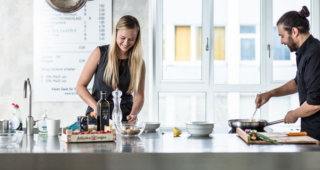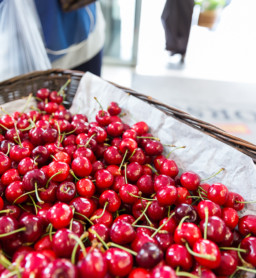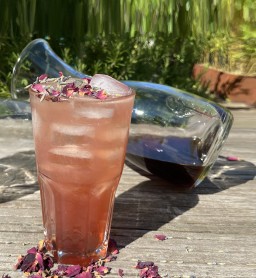It seems to be an interesting rule of thumb that the more we see of the world, the more closely we look at our home countries. And the more we end up focusing on everything that it has to offer. Suddenly, it’s those little differences that start jumping out at us, providing a tie that binds us to home. This also applies to food and eating habits. Which is why demand for regional products has been mushrooming for years now. It’s no coincidence local supermarkets are offering fruit and vegetables from local farmers. And it is no accident that information about provenance is displayed loud and proud on so many restaurant menus.

Food is the new pop
An insatiable hunger for new ideas is all part of the package for foodies. And 2018 has come along at just the right time. Many areas that are still to reach the public conscience – including three major hits – will shape the year: hyperlocal, smart food and the objectification of food.
Thema:
BioHacking
black ice cream
hyperlocal
NeuroNutrition
objectification of food
pink pineapple
Smart Food
hyperlocal
But in 2018, local just isn’t going to cut the mustard any more, with hyperlocal set to take its seat at the top table. Retailers will grow fruit and veg in the shop itself and diners will sit in restaurants surrounded by herb gardens and fruit trees. What separates local from hyperlocal is the immediacy of the sewing and harvesting experience. Sprouting is another food trend and watchword for the year ahead. When germinating seeds, it is all about the moment that a new plant comes into existence. Now ‘activated’, the seeds contain the maximum concentration of nutrients – and are ripe for harvesting. This is something that can be done at home – hyperlocally, if you like, to return to the subject at hand. Hyperlocal also applies to the tomato plant I have on my kitchen windowsill. This whole approach also ties in nicely to the central idea behind mindfulness.
Pigtail soup? This is the year we will develop a taste for it.
We shop more consciously and actively select products that we trust. It is also a question of making the most of the produce. Famously, cooks work from ‘root to stem’ and from ‘nose to tail’ – using every last scrap and letting virtually nothing go to waste. Taking beetroot as a case in point, we only really think about the root of the plant, but the vitamin-packed stems and leaves are also edible. Less well-known cuts of pork, beef and chicken are also being valued more.
Brain food
Since all of us are looking to optimise ourselves as well as our food these days, science is finding a place at our dining tables. As a discipline, neuronutrition explores the influence of food and nutrition on the brain. What’s the use of a health body if the mind is under the weather? In search of answers, researchers are looking for a formula to positively influence our cognitive abilities and prevent brain diseases.
‘hacking’ the body
The other new food-related field of research, biohacking, takes a different approach, looking instead at what kind of nutrition is right for each individual. This involves ‘hacking’ the body, by changing behavioural patterns and monitoring how it responds. Scenarios include skipping breakfast, doubling down on evening meals and doing away with dairy at lunch time. Hack by hack, people arrive at the perfect nutritional blend for their particular constitution and, with any luck, stay healthy. Or they identify foodstuffs that have a positive influence on pre-existing illnesses, something that the Squirrel Restaurant in London has already taken to heart. Here, unusual nutritional advice is also available alongside the classic accompanying wine. High cholesterol? Hmm, then we recommend menu number one. Anyone who orders a genetic testing kit from US start-up Habit can use the results of their home DNA test as the basis of a tailored healthy eating plan. Look at it this way: you are what you eat.
Online all the time
Ever ordered a Unicorn Frappuccino? Or doughnuts that glow in the dark? How about black ice cream or a Smurf-blue latté? The omnipresence of Instragram is constantly spawning interesting new creations. Still. And on it goes. Which is why 2018 will be more about the objectification of food than ever before. In other words: it has to look great on a photo. Delicious muesli is old hat. Today it’s all about the breakfast bowl. And the taste? Doesn’t matter. After all, the photo got 1,235 likes. American food producer Del Monte bred a pineapple with pink flesh for exactly this reason – and it was immediately hyped online using the #millenialpink hashtag.
A little less out-there, but still an interesting point, is that our teas are set to become that little bit more colourful. Flowers will make the transition from decorative elements to secret ingredients that add aromatic notes to our food and drink. Deep fried elderflower is reputed to taste fantastic, but we’ll need to take a look at the biohacking data first.



